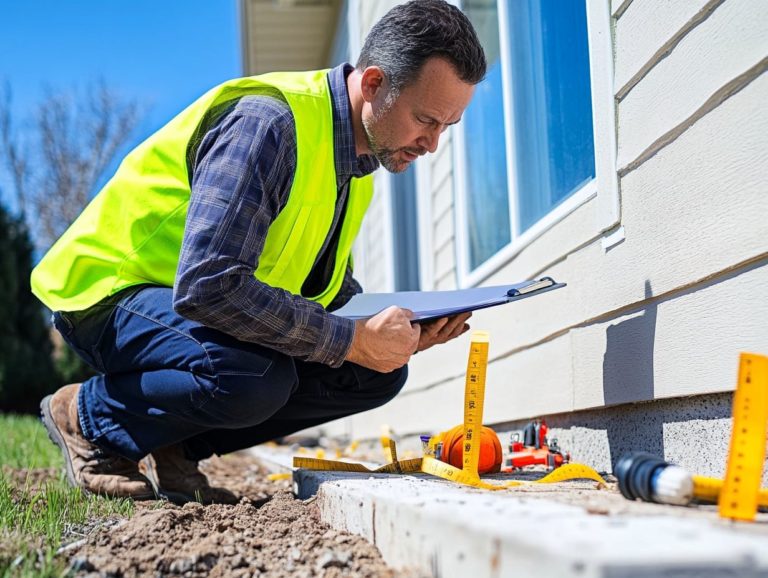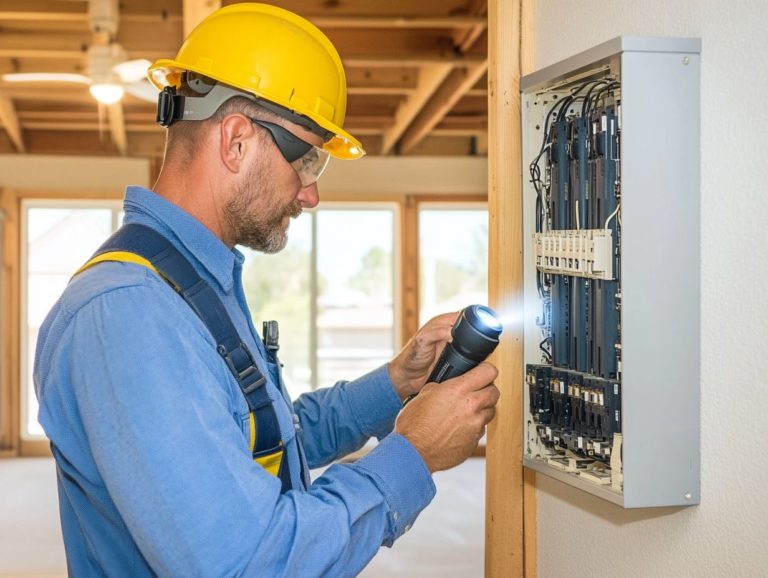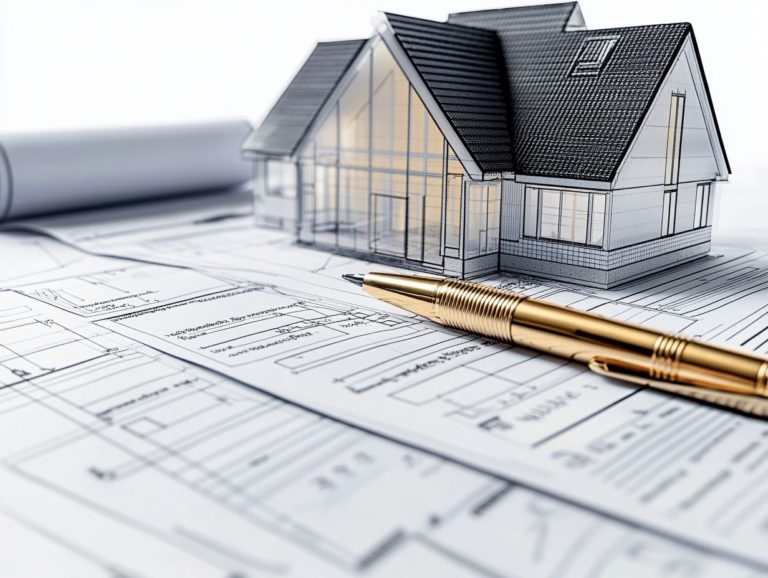Understanding Home Inspection Reports
A home inspection report is an indispensable asset for anyone involved in the buying or selling of property. It offers a thorough overview of a home’s condition, pinpointing structural, mechanical, and aesthetic aspects that could influence both value and safety.
This article meticulously dissects the components of a home inspection report, guiding you through its terminology and highlighting common findings you should be aware of. By the conclusion, you’ll be equipped with practical tips for reviewing and leveraging the report effectively, empowering you to make informed decisions throughout your real estate journey.
Contents
Key Takeaways:

A home inspection report provides a comprehensive evaluation of a property’s condition and helps buyers make informed decisions about potential investments. Understanding the home inspection process and its different components, such as structural and mechanical elements, can help identify potential issues and find practical solutions. It is important to review and interpret a home inspection report thoroughly, paying attention to terminology and symbols, in order to make informed decisions and negotiate repairs or adjustments with the seller.
What is a Home Inspection Report?
A home inspection report serves as a detailed analysis of a property’s condition, meticulously prepared by a certified home inspector. This document is essential for both home buyers and real estate agents, as it highlights safety concerns and significant issues related to the property. Understanding this report is crucial, so be sure to check out understanding the home inspection report for more insights.
In the realm of real estate transactions, this report is vital; it thoroughly evaluates the electrical systems, plumbing, HVAC systems (heating, ventilation, and air conditioning), and structural components, giving you the power to make informed decisions about your investment. With this knowledge, you can navigate the purchasing process with confidence and clarity.
Overview and Importance
Understanding the significance of a home inspection report is vital for you, whether you’re a home buyer or a real estate agent navigating a property transaction. This document acts as a snapshot of a property’s condition, highlighting critical issues and potential repairs that might not be readily apparent. For more detailed insights, you can explore what to expect in a home inspection report.
By carefully reviewing the findings, you can uncover essential insights into the property’s structural integrity, plumbing, electrical systems, and possible safety hazards. These assessments inform you about necessary repairs or ongoing maintenance and give you power in negotiations, allowing you to confidently address concerns with sellers.
With this knowledge, you are in a stronger position to advocate for concessions or price adjustments. Don t overlook these crucial assessments; they can save you from costly repairs later!
Components of a Home Inspection Report

A home inspection report consists of several vital components that collectively offer a comprehensive assessment of the property’s condition. This includes an examination of structural elements, HVAC systems, plumbing systems, and electrical systems, all designed to ensure you have a thorough understanding of the home’s overall state, including understanding home inspection standards.
Structural and Mechanical Elements
The structural and mechanical elements of a home inspection report are essential in evaluating the overall integrity and functionality of the property you re considering. Among these components, the electrical panel emerges as a key focal point; it not only manages the distribution of electricity throughout the home but can also pose a significant safety hazard if it s outdated or poorly maintained.
Equally critical is the HVAC system, which ensures temperature control and ventilation factors that greatly affect indoor air quality and comfort. You should also pay close attention to the plumbing systems, which must be thoroughly examined to avert water damage, leaks, or sewage problems that could lead to serious health risks.
Together, these systems are vital for providing a safe living environment. Overlooking their inspection could lead to costly repairs and heightened safety concerns for you and your loved ones.
Interior and Exterior Features
Examining both the interior and exterior features of a home is essential for your home inspection report. This provides valuable insights into the property s upkeep and maintenance requirements.
This evaluation covers critical elements such as the roofing condition, which can reveal potential leaks or structural concerns, as well as the durability of the siding. These aspects ensure your home remains protected against the elements.
Taking a closer look at the interior spaces allows you to assess the state of walls, floors, and fixtures. Each element plays a significant role in the overall livability of the property.
Regular maintenance preserves aesthetic appeal, enhances functionality, and extends the lifespan of various systems. Homeowners should act now to avoid costly repairs later.
Interpreting a Home Inspection Report

Interpreting a home inspection report requires grasping the terms used in home inspections and understanding what to look for in a home inspection report, including any defects identified, safety observations, and the overall summary of the report.
Understanding the report helps you address any concerns that arise.
Understanding Terminology and Symbols
Understanding the terms and symbols in a home inspection report is crucial for accurately interpreting the findings and recommendations from the certified home inspector. This is especially important when understanding the basics of home inspections.
These reports are often packed with technical language and abbreviations that can leave those unfamiliar with the inspection process feeling bewildered. For example, phrases like “immediate attention needed” or symbols indicating minor concerns can represent varying levels of issue severity.
Common notations, such as a thumbs-up or a warning triangle, provide essential insights into the property’s condition. Whether you’re a prospective home buyer or a real estate agent, understanding these symbols gives you the power to make informed decisions. This ensures that all parties grasp the potential risks and benefits associated with the property.
Identifying Potential Issues
Identifying potential issues highlighted in a home inspection report is essential for you as a home buyer. This enables you to address safety concerns and major issues that may require repairs.
By reviewing the inspection findings thoroughly, you can uncover hidden problems that might otherwise slip under your radar.
Acting on these findings secures your safety and helps you dodge unexpected expenses after buying the home.
Understanding these findings gives you the power to negotiate necessary repairs with the seller. Prioritizing these repairs before closing strengthens your position, allowing you to secure a safe and sound home, leading to a more informed and satisfying investment.
Common Findings in Home Inspection Reports

In home inspection reports, you ll frequently encounter critical areas of concern that demand your attention.
These reports often spotlight parts of the building and various safety issues that must be addressed before moving forward with any real estate transaction.
Examples and Solutions
In a home inspection report, you might encounter a range of findings, from minor cosmetic issues to significant concerns that demand immediate action to safeguard both the safety and value of your home. To navigate these findings effectively, consider understanding the process of home inspections.
Common problems can include outdated electrical systems, water damage, or roof leaks, which can be risky if ignored. For example, if you discover an older electrical panel, it may not comply with current inspection codes, potentially creating fire hazards and safety issues.
As a homebuyer, you should certainly negotiate for repairs, such as upgrading the system to meet modern standards. Similarly, any signs of water damage could signal plumbing problems or inadequate drainage, warranting prompt attention.
Tackling these issues not only ensures your safety but also has the potential to enhance your home s market value. Prioritize these findings during negotiations to protect your investment.
Make sure to review your home inspection report carefully. Taking action now will save you time and money!
Tips for Reviewing and Using a Home Inspection Report
Reviewing and utilizing a home inspection report effectively is essential for you as a home buyer. This crucial document can greatly influence your ability to negotiate contracts and request necessary repairs based on its findings. For more detailed insights, refer to understanding the home inspection process.
Understanding this report empowers you to make informed decisions and advocate for your interests throughout the purchasing process.
What to Look for and How to Proceed
When you review a home inspection report, it’s essential to know precisely what to look for. This includes navigating negotiations or repair requests effectively.
Key findings can provide you with significant leverage when discussing inspection conditions with the seller. Prioritize crucial aspects like plumbing integrity, electrical systems, and the overall stability of the home these are often the deal-breakers in your discussions.
When making repair requests, be concise and specific about what needs to be addressed. Include clear timelines for completion to strengthen your position.
Gathering supporting documents also helps you present a well-rounded argument, demonstrating your seriousness in negotiations.
Frequently Asked Questions
- What is included in a home inspection report?
A home inspection report describes the condition of the home s structure, interior and exterior, electrical and plumbing systems, heating and cooling systems, and major appliances. It may also include photographs, diagrams, and notes of any defects or issues found. - How is a home inspection report different from an appraisal?
A home inspection report is a comprehensive evaluation of a home’s condition, while an appraisal is an estimate of a home’s market value. An appraisal is typically required by lenders, while a home inspection is optional but highly recommended for buyers. - Who is responsible for conducting a home inspection?
A professional home inspector, usually hired by the buyer, is responsible for conducting a home inspection. They are trained and certified to thoroughly examine a home and provide a detailed report of their findings. - How long does a home inspection typically take?
The duration of a home inspection can vary depending on the size and condition of the home. On average, it can take between 2-4 hours to complete. However, larger or older homes may take longer to inspect. - Can a home inspection report be used to negotiate the price of a home?
Yes, a home inspection report can be used to negotiate the price of a home. If significant issues are found, buyers can use the report as leverage to negotiate a lower price or request repairs from the seller. - When should a home inspection report be done?
A home inspection report should be done after an offer has been made on a home, but before the closing of the sale. This allows the buyer to better understand the home’s condition and make an informed decision.
Always review your home inspection report thoroughly to protect your investment!






